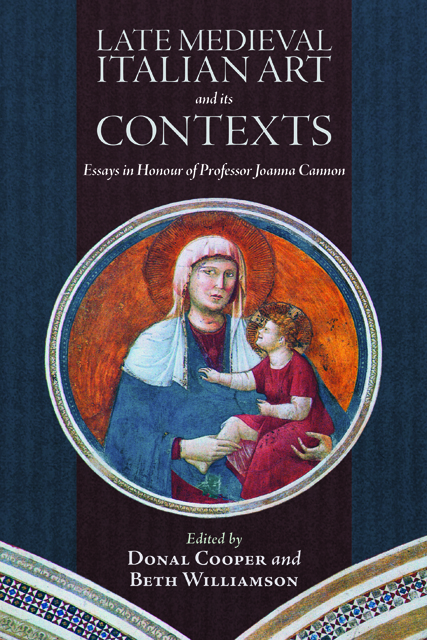Book contents
- Frontmatter
- Contents
- List of Illustrations
- List of Contributors
- Acknowledgements
- List of Abbreviations
- 1 Introduction: Circling Giotto
- 2 Holy Wood / ‘sacra tavola’: Saint Dominic and the Memory of Miracles in Bologna
- 3 The Sculpted Saint: A Statue of Saint Francis in Siena
- 4 Guccio di Mannaia and the Concept of a ‘Franciscan’ Chalice
- 5 ‘Speculum sine macula’: The Trittico di Santa Chiara in Trieste as an Object of Clarissan Devotion
- 6 The Siena Connection: A Franciscan Provincial Minister between Tuscany and Assisi at the Dawn of the Trecento
- 7 Simone Martini’s ‘Treaty with the House of Santa Fiora’ in Siena’s Palazzo Pubblico: Its Date and Significance
- 8 Crisis and Charity in Fourteenth-Century Florence: Ambrogio Lorenzetti’s Saint Nicholas Panels for San Procolo
- 9 Father of Light: Giotto and the Beatific Vision in the Baroncelli Chapel
- 10 Painter-Illuminator Workshops and the Church of San Giorgio a Ruballa: The Case of Bernardo Daddi and Pacino di Bonaguida
- 11 Patterns of Holiness: A Virgin Lactans in a Franciscan Context
- 12 A New Angle on Simone Martini’s Holy Family
- 13 Artistic Appropriation, Institutional Identity, and Civic Religion in Fourteenth-Century Siena: The Byzantine Treasury of the Hospital of Santa Maria della Scala
- 14 Visual Religious Education in Late Medieval Florence: Zanobi Perini, The Leggenda di Santo Tobia, and The Misericordia
- 15 Saints and Status in Late Medieval and Early Renaissance Florence
- Select Bibliography
- Publications by Joanna Cannon
- Index
- Tabula Gratulatoria
- Backmatter
4 - Guccio di Mannaia and the Concept of a ‘Franciscan’ Chalice
Published online by Cambridge University Press: 20 December 2022
- Frontmatter
- Contents
- List of Illustrations
- List of Contributors
- Acknowledgements
- List of Abbreviations
- 1 Introduction: Circling Giotto
- 2 Holy Wood / ‘sacra tavola’: Saint Dominic and the Memory of Miracles in Bologna
- 3 The Sculpted Saint: A Statue of Saint Francis in Siena
- 4 Guccio di Mannaia and the Concept of a ‘Franciscan’ Chalice
- 5 ‘Speculum sine macula’: The Trittico di Santa Chiara in Trieste as an Object of Clarissan Devotion
- 6 The Siena Connection: A Franciscan Provincial Minister between Tuscany and Assisi at the Dawn of the Trecento
- 7 Simone Martini’s ‘Treaty with the House of Santa Fiora’ in Siena’s Palazzo Pubblico: Its Date and Significance
- 8 Crisis and Charity in Fourteenth-Century Florence: Ambrogio Lorenzetti’s Saint Nicholas Panels for San Procolo
- 9 Father of Light: Giotto and the Beatific Vision in the Baroncelli Chapel
- 10 Painter-Illuminator Workshops and the Church of San Giorgio a Ruballa: The Case of Bernardo Daddi and Pacino di Bonaguida
- 11 Patterns of Holiness: A Virgin Lactans in a Franciscan Context
- 12 A New Angle on Simone Martini’s Holy Family
- 13 Artistic Appropriation, Institutional Identity, and Civic Religion in Fourteenth-Century Siena: The Byzantine Treasury of the Hospital of Santa Maria della Scala
- 14 Visual Religious Education in Late Medieval Florence: Zanobi Perini, The Leggenda di Santo Tobia, and The Misericordia
- 15 Saints and Status in Late Medieval and Early Renaissance Florence
- Select Bibliography
- Publications by Joanna Cannon
- Index
- Tabula Gratulatoria
- Backmatter
Summary
The role of the mendicant orders in the development of central Italian painting during the thirteenth and fourteenth centuries has been a recurring subject of debate within art history; indeed, Joanna Cannon’s research has shed much light on this area. Her work on issues of poverty, the development and dissemination of new forms, and Sienese altarpiece design has been highly influential. Alongside these art historical debates, liturgical historians have similarly examined the Franciscan Order’s contribution to developments in liturgy during the same period.
It is perhaps strange, then, that rather less attention has been paid to the liturgical vessels produced for mendicant use in general, and the Franciscans in particular. This observation must be tempered by the acknowledgement that one object has provoked much discussion. The extraordinary status of the chalice (Plate IV) created by the Sienese goldsmith Guccio di Mannaia for the Basilica of San Francesco in Assisi on behalf of Pope Nicholas IV has long been acknowledged, and indeed its reputation continues to increase. In 2014, for example, following a campaign of restoration and scientific study of the chalice, a monograph was produced dedicated to this single object, one of the most celebrated pieces of the goldsmith’s art to have been produced in the later Middle Ages. The chalice bears two inscriptions, the first naming Guccio as the chalice’s maker, while the second names the patron, Pope Nicholas IV. Unlike the gifts of liturgical apparatus given by Nicholas to the Basilica at Assisi immediately after his coronation as Pope, which seem to have been objects already in existence, the specifically Franciscan character of the chalice’s iconography as well as the inclusion of an image of Nicholas himself as Pope strongly suggest that it was a commission specifically undertaken for presentation to San Francesco. In this respect, it is similar to the embroidered altar decoration presented by Nicholas to the Basilica in 1289, a gift that was commemorated in its own bull, Excimatur ab intimis. Although undocumented, it is possible that the gift of the chalice might have followed a similar timetable. Guccio’s chalice is the earliest surviving example to present a new type of form, more vertical, more architectural in inspiration and making extensive use of figurative enamels, in a definitive split from the types of chalices in use during the thirteenth century.
- Type
- Chapter
- Information
- Late Medieval Italian Art and its ContextsEssays in Honour of Professor Joanna Cannon, pp. 51 - 68Publisher: Boydell & BrewerPrint publication year: 2022

